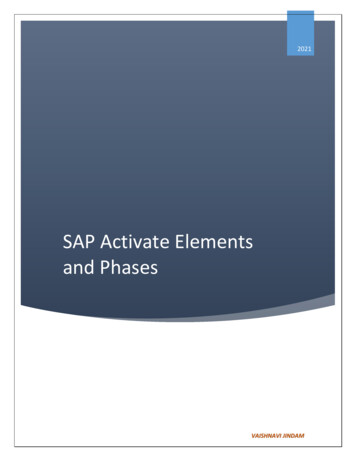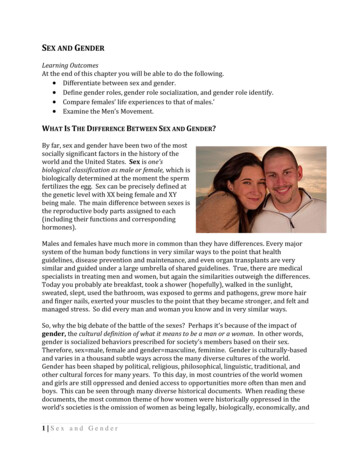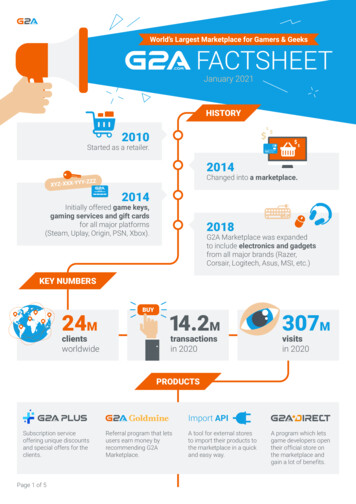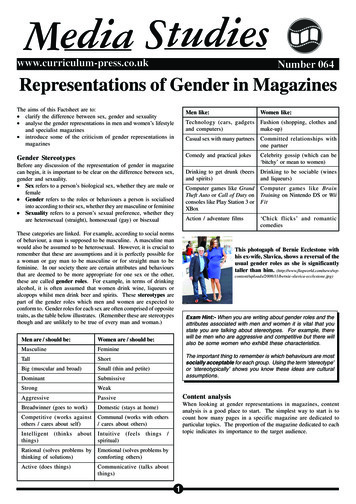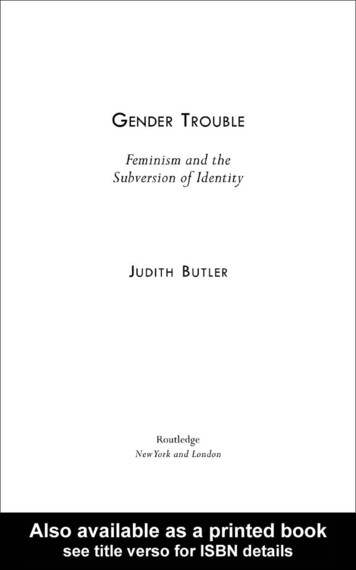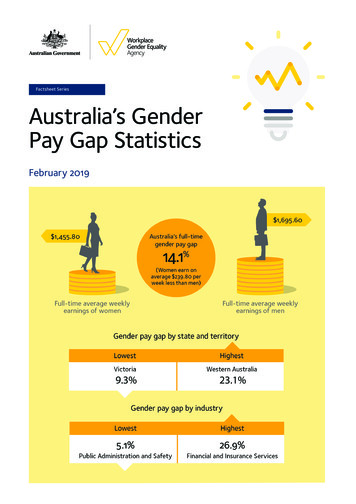
Transcription
Factsheet SeriesAustralia’s GenderPay Gap StatisticsFebruary 2019
About the Gender Pay GapThe gender pay gap (GPG) is the difference between women’s and men’s average weekly full-time equivalent earnings,expressed as a percentage of men’s earnings. It is a measure of women’s overall position in the paid workforce and doesnot compare like roles.The gender pay gap is influenced by a number of factors, including: discrimination and bias in hiring and pay decisions women and men working in different industries and different jobs, with female-dominated industries and jobsattracting lower wages women’s disproportionate share of unpaid caring and domestic work lack of workplace flexibility to accommodate caring and other responsibilities, especially in senior roles women’s greater time out of the workforce impacting career progression and opportunities.Gender pay gaps are an internationally established measure of women’s position in economy. Directly comparinginternational gender pay gaps is problematic due to differences in sources, definitions and methods used to calculate thegender pay gap in different countries.However, it is clear that gender pay gaps in favour of men are a common feature of economies worldwide.Calculating the Gender Pay GapAustralian gender pay gaps are calculated by the Workplace Gender Equality Agency (WGEA, the Agency). The GPG isderived as the difference between women’s and men’s average weekly full-time equivalent earnings, expressed as apercentage of men’s earnings.The data used by WGEA for calculating the national gender pay gap is the Australian Bureau of Statistics (ABS) Full-TimeAdult Average Weekly Ordinary Time Earnings Trend series from the Australian Weekly Earnings (AWE) survey.* Thesurvey estimates the full-time adult average weekly ordinary time earnings (trend) before tax, excluding factors such asovertime, pay that is salary sacrificed and junior and part-time employees. Trend data is less sensitive to seasonal changes,which can make the data ‘noisy’. Trend data smoothes out the noise and can give a better overview of the long termbehavior of the data.**Data is also sourced from the ABS Employee Earnings and Hours employer survey*** (age group and method of setting pay)and from the Agency’s own gender pay gap data (occupation and overall).**** Gender pay gap calculations derived fromeach of these data sources vary due to differences in timing and scope, and reflect different gender equality issues.ABS and WGEA data both show a gender pay gap favouring full-time working men over full-time working women in everyindustry and occupational category in Australia.**********ABS (2019), Average Weekly Earnings, November 2018, cat. no. 6302.0, viewed 20 February 02.0ABS (2012), Interpreting Time Series: Are you being misled by the Seasons, 2012, viewed 20 February p/1346.0.55.003Main Features202012ABS (2017), Employee Earnings and Hours, Australia, May 2018, cat. no. 6306.0, viewed 20 February 06.0WGEA (2019), WGEA Data Explorer: http://data.wgea.gov.au/www.wgea.gov.au Workplace Gender Equality Agency2
The national gender pay gapThe national gender pay gap is calculated by WGEA using data fromthe ABS.Currently, Australia’s national gender pay gap is 14.1%.At November 2018, women’s average weekly ordinary full-timeearnings across all industries and occupations was 1,455.80compared to men’s average weekly ordinary full-time earnings of 1,695.60.The national gender pay gap over timeAustralia’s national gender pay gap has hovered between 14% and 19% for the past two decades.* There has been adecrease of 1.1 pp in the gender pay gap since November 2017 (15.2%).Between 1998 and 2018 the national gender pay gap was: lowest in November 2018, at 14.1% highest in November 2014, at 18.5%.Figure 1: The Australian national gender pay gap, November 1998 - November 2018**20Nov-201418.5%Percentage (%)1816141210PLACE HOLDERNov 201814.1%Data source: ABS (2019), Average Weekly Earnings, November 2018, cat. no. 6302.0, viewed 21 February 2019, http://www.abs.gov.au/ausstats/abs@.nsf/mf/6302.0 Note: Based on full-time adult average weekly ordinary time earnings, trend series.***Unless otherwise stated, all measures of the gender pay gap are expressed as a percentage (%) based on average weeklyordinary time earnings for full-time employees (trend data), with changes over time provided as the percentage point (pp)difference.The release frequency changed from quarterly to bi-annual between May and November 2012. May 2012 represents the start ofthe new bi-annual series.www.wgea.gov.au Workplace Gender Equality Agency3
WGEA DataWGEA collects pay data annually from non-public sector organisations with 100 or more employees, covering more than 4million employees in Australia. This data includes superannuation, bonuses and other additional payments.The full-time total remuneration gender pay gap based on WGEA data is 21.3%, meaning men working full-time earn nearly 25,717 a year more than women working full-time.Figure 2: Full-time base salary and total remuneration, 2013-14 to 2017-18Change in full-time base salary and total remuneration gender pay gaps (GPG)Total remunerationGPGBase salary GPG3024.7 %25%201519 .9 %2013-1424.0%23 .1 %19.1 %2014-1517 .7 %2015-1622.4 %21.3 %17 .3 %16 .2 %2016-172017-18Source: WGEA (2018), Australia’s gender equality scorecard, nts/WGEA 2017-18%20Gender%20Equality%20Scorecard.pdfNote: Based on total remuneration of full-time employees, which includes full-time base salary plus any additional benefits payable directly or indirectly,whether in cash or in a form other than cash. Includes: bonus payments (including performance pay), superannuation, discretionary pay, overtime, otherallowances and other benefits (for example share allocations).The gender pay gapby state and territoryThe full-time average weekly base salary gender pay gap differs across Australian states and territories. The differencesin the gender pay gap can be partly explained by industry profiles of each state and territory. For example, the full-timeworkforce in Western Australia is concentrated in Mining and Construction sectors, industries with relatively high earningsand low representation of women. In contrast, the majority of the full-time workforce in the Australian Capital Territoryis employed in the Public Administration and Safety sector, which traditionally has a lower gender pay gap and balancedgender representation. As of November 2018: Western Australia has the widest gender pay gap at 23.1%. Victoria and South Australia have the smallest gender pay gaps at 9.3% and 9.4% respectively.Between 2017 and 2018 the gender pay gap has decreased in the Northern Territory and Victoria by 5.1 and 3.1 percentagepoints (pp) respectively, followed by South Australia with a decrease of 0.8 percentage points. The Australian CapitalTerritory and Western Australia were the only regions to record higher gender pay gaps, with increases of 1.7 and 0.6percentage points respectively.www.wgea.gov.au Workplace Gender Equality Agency4
Table 1: Full-Time Adult Weekly Ordinary Time Earnings gender pay gap by state and territory, November 2017November erence (pp)Western Australia22.523.10.6Queensland17.917.3-0.6Northern Territory20.615.5-5.1Australian Capital Territory12.614.31.7New South Wales14.313.8-0.5Tasmania10.710.3-0.4South .414.6-0.8Data source: ABS (2019), Average Weekly Earnings, November 2018, cat. no. 6302.0, viewed 21 February 2019, http://www.abs.gov.au/ausstats/abs@.nsf/mf/6302.0 Note: Based on Full-Time Adult Average Weekly Ordinary Time Earnings with November as the reference period. States and territories are ranked fromhighest gender pay gap to lowest gender pay gap in November 2018, followed by the national gender pay gap result.The gender pay gap by industryThe differences between women’s and men’s average weekly full-time earnings across all industries, including the privateand public sectors, shows that across Australia the gender pay gap is: highest in Financial and Insurance Services with 26.9%, followed by Health Care and Social Assistance with 25.8% andRental, Hiring and Real Estate Services with 22.7% lowest in Public Administration and Safety with 5.1% and Retail Trade with 5.2%Between November 2017 and 2018: the largest gender pay gap increases were in Health Care and Social Assistance ( 3.0 pp), Other Services ( 2.2 pp) andMining ( 0.9 pp) the largest decrese in the gender pay gap were in Construction (-7.7 pp), Accommodation and Food Services (-3.2 pp),and Retail (-2.9 pp)*A minus sign indicates that the gender pay gap has decreased from the previous periodwww.wgea.gov.au Workplace Gender Equality Agency5
Table 2Full-time Adult Average Weekly Ordinary Time Earnings gender pay gap by industry, November 2017- ancial and insuranceservices26.126.90.8Health Care and SocialAssistance22.825.83.0Rental, Hiring and RealEstate Services23.622.7-0.9Professional, Scientific andTechnical Services22.621.2-1.4Arts and RecreationServices23.021.1-1.9Information Media Transport, Postal andWarehousing17.915.7-2.2Administrative and nstruction20.212.5-7.7Education and icity, Gas, Water andWaste Services10.510.1-0.4Other Services6.89.02.2Accommodation and FoodServices11.68.4-3.2Retail8.15.2-2.9Public Administration andSafety6.85.1-1.7Data source: ABS (2019), Average Weekly Earnings, November 2018, cat. no. 6302.0, viewed 22 February 2019, https://www.abs.gov.au/ausstats/abs@.nsf/mf/6302.0 Note: Based on Full-Time Adult Average Weekly Ordinary Time Earnings with November as the reference period. Industries are ranked from highest genderpay gap to lowest gender pay gap in May 2018.*A minus sign indicates that the gender pay gap has decreased from the previous period.www.wgea.gov.au Workplace Gender Equality Agency6
Gender pay gaps in the privatesectorIn November 2018, the gender pay gap was 17.7% in the private sector and 10.4% in the public sector. Figure 3 shows thatsince 1998 the gender pay gap in the public sector has been considerably lower than in the private sector.Since 1998, the gender pay gap has hovered between 17.4% and 22.1% in the private sector and between 13.5% and 10.4% inthe public sector.Figure 3: Gender pay gaps over time in the private and public sectors, November 1998 - November 201825PrivatePublicPercentage (%)2017.7151010.450Data source: ABS (2019), Average Weekly Earnings, November 2018, cat. no. 6302.0, viewed 22 February 2018, http://www.abs.gov.au/ausstats/abs@.nsf/mf/6302.0 Note: Based on full-time adult average weekly ordinary time earnings.Method of setting pay and the gender pay gapThe method of setting pay describes how salaries are established, usually by award, collective or individual agreement.Table 3 shows, that in 2018, the gender pay gap was higher when pay was set by individual arrangement, compared towhen pay was set by award or collective agreement.The data shows that on average men have higher weekly total cash earnings than women regardless of the method bywhich pay is set.Table 3: Average weekly total cash earnings (full-time) by gender and gender pay gap by method of settingpay (2018)Method of Setting PayWomenMenGender Pay Gap(%)Award or Collective agreement 1,492.80 1,732.8013.9Individual arrangement 1,549.60 1,898.4018.4Overall 1,515.60 1,810.9016.3Data source: ABS (2019), Employee Earnings and Hours, Australia, May 2018, cat. no. 6306.0, viewed 21 February 2018, e/6306.0May%202018?OpenDocumentNote: Based on full-time average weekly total cash earnings and inclusive of ordinary and overtime earnings.www.wgea.gov.au Workplace Gender Equality Agency7
The gender pay gap by age groupThe average gender pay gap between women and men working full-time increases with age up to the mid-30s beforedecreasing slightly to 15.6% in favour of men in the mid-40s. The average gender pay gap then increases again to 17.7% forthe 55 years and over age group.The average gender pay gap is smallest for employees aged 20 years and under and sharply increases for those agedbetween 21 and 34 years. The gender pay gap is at its widest for the 35 to 44 years age group and for those over 55 years.The average gender pay gap increases to its highest point at 17.7% for the 55 years and over age group. Women in this agegroup are more likely than men to have spent time out of the workforce to care for children. As a result of the extra timewomen spend in unpaid care work, they have fewer promotion opportunities and are less likely than men to hold highlycompensated jobs.Figure 4: Average weekly full-time earnings and gender pay gap by age, May .01,500.0012.010.01,000.008.06.0500.00Gender pay gap (%)Average weekly full-time earnings ( )17.34.01.92.00.000.020 years andunder21 to 34 years35 to 44 years45 to 54 years 55 years and overAll agesAge (years)WomenMenGPGData source: ABS (2019), Employee Earnings and Hours, Australia, May 2018, cat. no. 6306.0, viewed 18 February 2019, ote: Based on full-time average weekly total cash earnings and inclusive of ordinary and overtime earnings.www.wgea.gov.au Workplace Gender Equality Agency8
The gender pay gap by occupationOccupational full-time gender pay gaps are calculated across the WGEA dataset by management and non-managementoccupational categories. The calculations are based on the annualised base salary and total remuneration of employees innon-public sector organisations.Overall, WGEA data shows that in 2018 the gender pay gap was higher among managers compared to non-managers. Thesmaller gender pay gap is largely due to less discretionary pay and greater reliance on awards and collective agreementsamong non-managers. In 2018: the gender pay gap for all managers was 25.7% with an average total remuneration dollar difference of 50,370 the gender pay gap for all non-managers was 19.0% with an average total remuneration dollar difference of 19,830.The gender pay gap by manager categoryWGEA data across manager categories shows that gender pay gaps increase at higher levels of management. The genderpay gap in total remuneration in part reflects the role of non-salary benefits in management, including bonuses. In 2018: the highest average full-time total remuneration gender pay gap was for key management personnel at 24.3%. Thismeans that on average, women earn 91,003 less than men.Figure 5: Full-time total remuneration gender pay gaps by manager category and non-manager occupationSource: WGEA (2019), WGEA Data Explorer: http://data.wgea.gov.au/Note: Based on total remuneration of full-time employees, which includes full-time base salary plus any additional benefits payable directly or indirectly,whether in cash or in a form other than cash. Includes bonus payments (for example, performance pay), superannuation, discretionary pay, overtime,other allowances and other benefits (for example, share allocations).www.wgea.gov.au Workplace Gender Equality Agency9
The gender pay gap by occupational category WGEA data for non-manager occupations shows a gender pay gap in favour of men across all occupational categories.The gender pay gap in total remuneration partly reflects the role of non-salary benefits, including bonuses acrossspecific occupations. For example, Technicians, which includes engineers, are likely to receive bonuses uponcompletion of projects. In 2017-18: the highest gender pay gap by occupation was for Technicians and trade, at 26.4% full-time total remuneration the lowest gender pay gap by occupation was for Clerical and administrative, at 8.3% full-time remuneration.Figure 6: Gender pay gaps by non-manager occupations (full-time employees, base salary and totalremuneration), 2018Source: WGEA (2019), WGEA Data Explorer: http://data.wgea.gov.au/Note: Based on total remuneration of full-time employees, which includes full-time base salary plus any additional benefits payable directly or indirectly,whether in cash or in a form other than cash. Includes bonus payments (for example, performance pay), superannuation, discretionary pay, overtime,other allowances and other benefits (for example, share allocations).WGEA ResourcesWGEA Data Explorer: displays gender pay gap data (based on a census of non-public sector organisations with 100 ormore employees that are required to report to the Agency and representing over 40% of Australian employees)Australia’s gender equality scorecard: released in November 2018Gender Equity Insights Reports: Inside Australia’s Gender Pay Gap: released March 2017 for a more detailed analysis of theAgency’s gender pay gap data (such as by governing boards’ gender composition and by whether organisations are morefemale-dominated, male-dominated or mixed).www.wgea.gov.au Workplace Gender Equality Agency10
Advice and assistanceFor further advice and assistance,please contact:Workplace Gender Equality AgencyLevel 7, 309 Kent StreetSydney NSW 2000T: 02 9432 7000 or 1800 730 233E: wgea@wgea.gov.auwww.wgea.gov.auFollow us on social media@WGEAgency@wgeagencySearch Workplace GenderEquality Agency
The gender pay gap (GPG) is the difference between women’s and men’s average weekly full-time equivalent earnings, expressed as a percentage of men’s earnings. It is a measure of women’s overall position in the paid workforce and does . ABS and WGEA data both show a gender pay gap f


